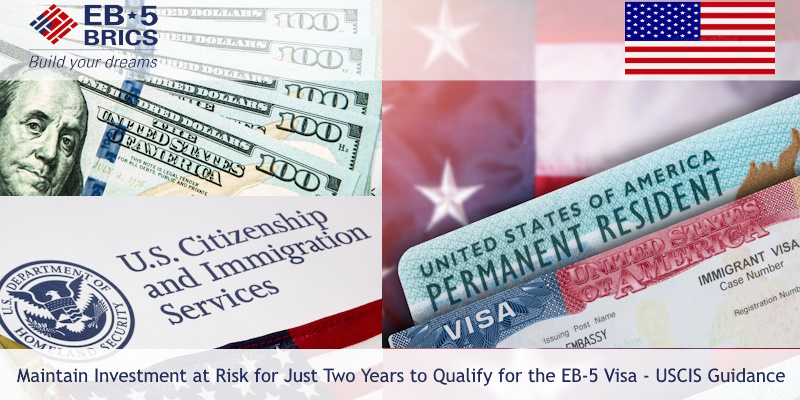
The USCIS has issued guidance clarifying the duration of investment for EB-5 investors applying after the enactment of the EB-5 Reform and Integrity Act of 2022 (RIA).
This guidance removes all uncertainty around how long an EB-5 investor applying after March 15, 2022—the date of enactment of the RIA—must sustain or maintain their EB-5 investments.
To understand the significance of this guidance, it is important to understand how the EB-5 backlog impacted investment timelines for applicants from China, India, and Vietnam.
Pre-RIA Investment Timelines—No Backlog
If there is no backlog, deployment of investment will take place simultaneously with I-526 approval and grant of conditional permanent residence. The investment will remain deployed through this two-year period. So, it was easy for investors to maintain the investment through the period of conditional permanent residence.
Pre-RIA Investment Timelines—Backlog
The scenario changes drastically if the applicant’s priority date is not current at the time of I-526 approval. The investment gets deployed after I-526 approval but the conditional permanent residence begins only after the visa becomes available, which can involve a very long waiting period due to the backlog.
EB-5 investors from China have faced waiting periods in excess of ten years to become conditional permanent residents.
If an investor had to wait for eight years for the EB-5 visa to become available, then the total duration of the investment would be ten years—eight years plus the two-year period of conditional permanent residence.
This exposed the investor to a lot of uncertainty because the investment had to be maintained at risk until the end of conditional permanent residence.
Further, the Regional Center might return the investment, which meant the investor had to redeploy to maintain the at-risk status until approval of the I-751 petition for removal of conditions.
Revised Investment Timelines Under the Reform and Integrity Act
Until the RIA, all EB-5 investors were required to sustain their EB-5 investment until the end of the two-year period of conditional permanent residence.
The RIA removed the reference to the applicant’s conditional permanent residence. Instead, it required all EB-5 applicants to remain invested for a period of at least two years to fulfill the general requirement of investment under the EB-5 program.
This was a significant change because investors were now required to stay invested for a period of two years irrespective of whether they had received conditional permanent residence or not.
However, the law did not specify when this two-year time period would commence. The USCIS guidance has clarified that the two-year period will commence from the date on which the qualifying investment is made. So, the applicant’s two-year investment period will begin from the date on which the investment was contributed to the New Commercial Enterprise and placed at risk.
The provision of the RIA combined with the USCIS guidance has come as a significant positive development for all EB-5 investors, especially those from countries like China, India, and Vietnam.
Moving forward, the investor can deploy the investment after filing their I-526E and fulfill the investment requirement by keeping the investment at risk for a period of two years and creating the required number of jobs.
Once this requirement is fulfilled, the investment can be returned without any impact on the grant of conditional permanent residence or removal of conditions at the end of the two-year period.
The RIA and the USCIS guidance have decoupled the investment timeline from the processing timeline of the EB-5 visa. Even if the investor faces an eight-year wait for the visa to become available, he or she must maintain the investment at risk for a period of just two years commencing from the date of the investment.
So, if the jobs have been created, then the legal obligation to maintain the investment to qualify for the EB-5 visa ends after the two-year period. This is irrespective of whether the EB-5 visa is available or not or whether the applicant has been granted conditional permanent residence or not.
While not legally obligated to do so, the investor may remain invested due to the way Regional Center investments are structured.
EB-5 investments in real estate and other types of projects are usually structured as debt issued by the new commercial enterprise to the job creating enterprise i.e. loan from the regional center EB-5 partnership to the borrower. These investments have a tenure of not less than five years because it generally takes that long for the project to be constructed and stabilized for recapitalization and sale or refinance. So, the actual return of investment is unlikely to happen in just two years.
However, investors will no longer have to extend or reinvest or redeploy the investment to fulfill the at-risk requirement to remain eligible for the EB-5 visa. The legal obligation ends after two years and whether the investment continues beyond that will depend on commercial and practical aspects only.
Impact on Set-Aside Visas
The RIA has set aside 20%, 10%, and 2% of all EB-5 visas available in a year for projects in rural areas, high-unemployment areas, and infrastructure projects respectively.
While no country is facing a backlog in these reserved categories, this can change in the future and even those investing in reserved category projects may have to wait for their priority date to become current to get the EB-5 visa.
The latest guidance removes all gray areas and requires investors to maintain their investment for a period of two years only. So, a backlog in the EB-5 set aside visa category will not expose the investor to an at-risk investment for an extended period of time.
As long as the investor can prove that the investment was maintained at risk for two years and that the requisite number of jobs were created, he or she will remain eligible for the EB-5 visa irrespective of how long it takes for the investor to receive conditional permanent residence.


